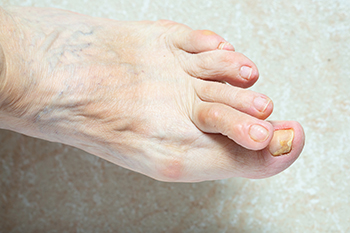Connect With Us
Blog

When a child injures an ankle, it is often assumed to be a sprain, which occurs when the ligaments that stabilize the joint are stretched or torn, typically from a sudden twist, roll, or awkward landing. Most ankle sprains involve the foot turning inward, a motion called inversion, and may result from sports, running, or stepping on uneven ground. Symptoms like swelling, bruising, and difficulty bearing weight are common. However, similar symptoms can also indicate other issues, such as a growth plate injury or a fracture, which require different care. Because children’s bones are still developing, it is important not to overlook the possibility of a more serious condition. A podiatrist can assess the injury by examining the foot and ankle, testing movement, and ordering imaging, if needed, to confirm the diagnosis. Early evaluation helps prevent complications like chronic instability or improper healing. If you believe your child has sprained an ankle, it is suggested that you promptly schedule an appointment with a podiatrist for an exam and appropriate treatment.
Although ankle sprains are common, they aren’t always minor injuries. If you need your ankle injury looked at, contact Raul Hidalgo DPM from South Texas Foot & Ankle Care. Our doctor can provide the care you need to keep you pain-free and on your feet.
How Does an Ankle Sprain Occur?
Ankle sprains are the result of a tear in the ligaments within the ankle. These injuries may happen when you make a rapid shifting movement while your foot is planted. A less common way to sprain your ankle is when your ankle rolls inward while your foot turns outward.
What Are the Symptoms?
- Pain at the sight of the tear
- Bruising/Swelling
- Ankle area is tender to touch
- In severe cases, may hear/feel something tear
- Skin discoloration
Preventing a Sprain
- Wearing appropriate shoes for the occasion
- Stretching before exercises and sports
- Knowing your limits
Treatment of a Sprain
In many cases, the RICE method (Rest, Ice, Compression, and Elevate) is used to treat ankle sprains. However, you should see a podiatrist to see which treatment option would work best with your injury. In severe cases, surgery may be required.
It is important to ask your doctor about rehab options after you receive treatment for your injury. Stretching, strength training, and balance exercises may help the ankle heal while also preventing further injury.
If you have any questions, please feel free to contact our office located in San Antonio, TX . We offer the newest diagnostic and treatment technologies for all your foot care needs.

Hammertoe causes one or more toes to bend downward at the middle joint, often due to muscle imbalance or years of wearing tight or narrow shoes. This condition can lead to pain, stiffness, and difficulty in finding comfortable footwear. Early care focuses on relieving pressure and improving toe alignment. Switching to shoes with a deep, wide toe box can reduce friction and prevent further irritation. Toe cushions or splints may help straighten the toe and ease discomfort. Gentle stretching exercises can improve flexibility and reduce stiffness. If the toe becomes rigid or painful with movement, medical treatment may be needed. Options include custom orthotics, anti-inflammatory care, or surgery, in more severe cases. If you are experiencing persistent pain or difficulty with footwear, it is suggested that you see a podiatrist for a diagnosis and treatment plan tailored to your condition.
Hammertoes can be a painful condition to live with. For more information, contact Raul Hidalgo DPM of South Texas Foot & Ankle Care. Our doctor will answer any of your foot- and ankle-related questions.
Hammertoe
Hammertoe is a foot deformity that occurs due to an imbalance in the muscles, tendons, or ligaments that normally hold the toe straight. It can be caused by the type of shoes you wear, your foot structure, trauma, and certain disease processes.
Symptoms
- Painful and/or difficult toe movement
- Swelling
- Joint stiffness
- Calluses/Corns
- Physical deformity
Risk Factors
- Age – The risk of hammertoe increases with age
- Sex – Women are more likely to have hammertoe compared to men
- Toe Length – You are more likely to develop hammertoe if your second toe is longer than your big toe
- Certain Diseases – Arthritis and diabetes may make you more likely to develop hammertoe
Treatment
If you have hammertoe, you should change into a more comfortable shoe that provides enough room for your toes. Exercises such as picking up marbles may strengthen and stretch your toe muscles. Nevertheless, it is important to seek assistance from a podiatrist in order to determine the severity of your hammertoe and see which treatment option will work best for you.
If you have any questions, please feel free to contact our office located in San Antonio, TX . We offer the newest diagnostic and treatment technologies for all your foot care needs.
Blog Archives
- June 2025
- May 2025
- April 2025
- March 2025
- February 2025
- January 2025
- December 2024
- November 2024
- October 2024
- September 2024
- August 2024
- July 2024
- June 2024
- May 2024
- April 2024
- March 2024
- February 2024
- January 2024
- December 2023
- November 2023
- October 2023
- April 2022
- March 2022
- February 2022
- January 2022
- December 2021
- November 2021
- October 2021
- September 2021
- August 2021
- July 2021
- June 2021
- May 2021
- April 2021
- March 2021
- December 2018
- November 2018
- October 2018
- September 2018
- August 2018
- July 2018
- June 2018
- May 2018
- April 2018
- March 2018
- February 2018
- January 2018
- December 2017
- November 2017
- October 2017


